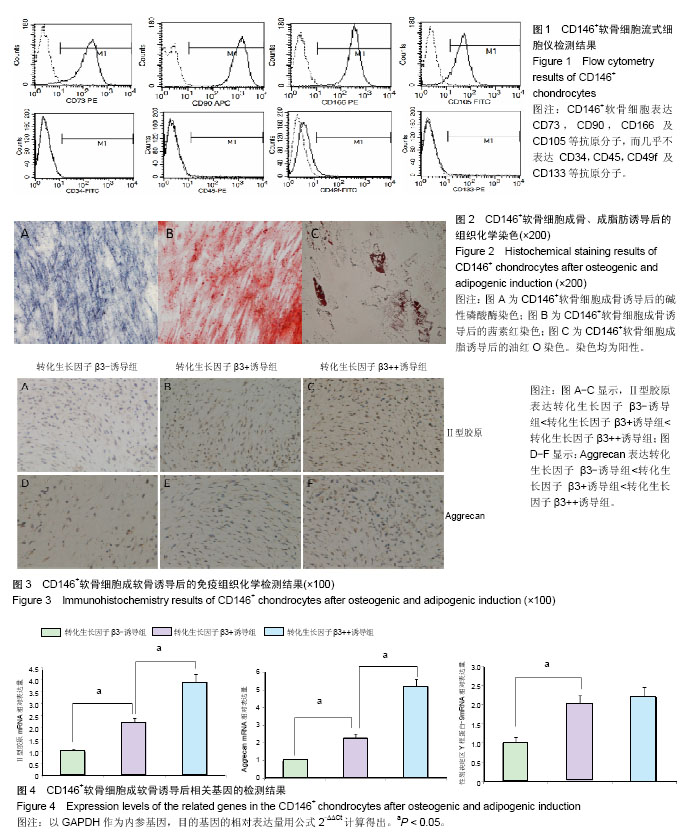| [1] Cucchiarini M,Henrionnet C,Mainard D,et al.New trends in articular cartilage repair.J Exp Orthop.2015; 2(1): 8.[2] Yuan XL,Meng HY,Wang YC,et al.Bone-cartilage interface crosstalk in osteoarthritis: potential pathways and future therapeutic strategies.Osteoarthritis Cartilage.2014;22(8): 1077-1089.[3] Makris EA, Gomoll AH, Malizos KN,et al.Repair and tissue engineering techniques for articular cartilage.Nat Rev Rheumatol. 2015; 11(1): 21-34.[4] Perera JR, Gikas PD, Bentley G.The present state of treatments for articular cartilage defects in the knee. Ann R Coll Surg Engl. 2012;94(6): 381-387.[5] Cui D,Li H,Xu X,et al. Mesenchymal Stem Cells for Cartilage Regeneration of TMJ Osteoarthritis. Stem Cells Int. 2017;2017: 5979741.[6] Findlay DM,Kuliwaba JS.Bone-cartilage crosstalk: a conversation for understanding osteoarthritis.Bone Res.2016;4:16028. [7] Liu M,Yu X,Huang F, et al. Tissue engineering stratifed scaffolds for articular cartilage and subchondral bone defects repair. Orthopedics.2013; 36(11): 868-873.[8] Viti F,Scaglione S,Orro A,et al.Guidelines for managing data and processes in bone and cartilage tissue engineering. BMC Bioinformatics. 2014;15 Suppl 1: S14.[9] Phull AR, Eo SH,Abbas Q, et al. Applications of Chondrocyte- Based Cartilage Engineering: An Overview. Biomed Res Int. 2016; 2016: 1879837.[10] Goldberg A,Mitchell K,Soans J,et al.The use of mesenchymal stem cells for cartilage repair and regeneration: a systematic review. J Orthop Surg Res. 2017; 12(1): 39.[11] Su X,Zuo W,Wu Z,et al.CD146 as a new marker for an increased chondroprogenitor cell sub-population in the later stages of osteoarthritis.J Orthop Res.2015;33(1):84-91.[12] 左伟,吴志宏,苏新林,等.软骨来源成体干细胞的分离及其鉴定.基础医学与临床,2014,33(4):412-417.[13] Murphy MK, Huey DJ,Hu JC,et al.TGF-β1, GDF-5, and BMP-2 stimulation induces chondrogenesis in expanded human articular chondrocytes and marrow-derived stromal cells. Stem Cells.2015; 33(3):762-773.[14] Alsalameh S,Amin R,Gemba T,et al.Identification of mesenchymal progenitor cells in normal and osteoarthritic human articular cartilage. Arthritis Rheum. 2004;50(5):1522-1532. [15] Fickert S,Fiedler J,Brenner RE.Identification of subpopulations with characteristics of mesenchymal progenitor cells from human osteoarthritic cartilage using triple staining for cell surface markers. Arthritis Res Ther.2004;6(5):R422-432.[16] Dowthwaite GP,Bishop JC,Redman SN, et al.The surface of articular cartilage contains a progenitor cell population.J Cell Sci. 2004;117(6): 889-897.[17] Crisan M, Yap S, Casteilla L, et al.A perivascular origin for mesenchymal stem cells in multiple human organs. Cell Stem Cell.2008; 3(3): 301-313.[18] Sorrentino A, Ferracin M, Castelli G, et al. Isolation and characterization of CD146+ multipotent mesenchymal stromal cells. Exp Hematol. 2008; 36(8): 1035-1046.[19] Stopp S, Bornhauser M, Ugarte F, et al.Expression of the melanoma cell adhesion molecule in human mesenchymal stromal cells regulates proliferation, differentiation, and maintenance of hematopoietic stem and progenitor cells. Haematologica. 2013; 98(4): 505-513.[20] Tormin A,Li O,Brune JC,et al.CD146 expression on primary nonhematopoietic bone marrow stem cells is correlated with in situ localization. Blood.2011;117(19):5067-5077.[21] Dominici M, Le Blanc K, Mueller I, et al. Minimal criteria for defining multipotent mesenchymal stromal cells. The International Society for Cellular Therapy position statement. Cytotherapy; 2006;8(4):315-317.[22] Tao K, Frisch J, Rey-Rico A, et al. Co-overexpression of TGF-β and SOX9 via rAAV gene transfer modulates the metabolic and chondrogenic activities of human bone marrow-derived mesenchymal stem cells. Stem Cell Res Ther.2016; 7: 20.[23] Zhai G, Doré J, Rahman P. TGF-β signal transduction pathways and osteoarthritis.Rheumatol Int. 2015;35(8):1283-1292.[24] Kwon H, Paschos NK, Hu JC, et al. Articular cartilage tissue engineering: the role of signaling molecules. Cell Mol Life Sci. 2016;73(6):1173-1194.[25] Poniatowski ?A, Wojdasiewicz P, Gasik R, et al. Transforming growth factor Beta family: insight into the role of growth factors in regulation of fracture healing biology and potential clinical applications. Mediators Inflamm.2015;2015:137823.[26] Sefat F, Denyer MC, Youseffi M. Effects of different transforming growth factor beta (TGF-β) isomers on wound closure of bone cell monolayers. Cytokine.2014;69(1):75-86. [27] Morikawa M,Derynck R,Miyazono K.TGF-β and the TGF-β Family: Context-Dependent Roles in Cell and Tissue Physiology. Cold Spring Harb Perspect Biol.2016;8(5). [28] 丁然,王庆,蔡贤华,等.转化生长因子-β不同亚型对前软骨干细胞增殖分化的影响[J].华中科技大学学报:医学版.2013;42(6):659-664.[29] Zhang X,Wu S,Naccarato T,et al.Regeneration of hyaline-like cartilage in situ with SOX9 stimulation of bone marrow-derived mesenchymal stem cells. PLoS One.2017; 12(6): e0180138.[30] Shi S,Wang C,Acton AJ,et al.Role of Sox9 in Growth Factor Regulation of Articular Chondrocytes. J Cell Biochem.2015; 116(7):1391-1400.[31] Lefebvre V,Dvir-Ginzberg M.SOX9 and the many facets of its regulation in the chondrocyte lineage.Connect Tissue Res.2017; 58(1):2-14. |
.jpg) 文题释义:
骨软骨前体细胞:分布在不同组织中的间充质干细胞可以视为组织特异性干细胞,一定条件下可向相应组织的成熟细胞分化,骨软骨前体细胞也称为骨软骨祖细胞,是指在特定条件下能够分化为骨细胞及软骨细胞的间充质干细胞。
转化生长因子β:是属于一组新近发现的调节细胞生长和分化的转化生长因子β超家族。这一家族除转化生长因子β外,还有活化素(activins)、抑制素(inhibins)、缪勒氏管抑制质(Mullerian inhibitor substance,MIS)和骨形成蛋白。转化生长因子β的命名是根据这种细胞因子能使正常的成纤维细胞的表型发生转化,即在表皮生长因子同时存在的条件下,改变成纤维细胞贴壁生长特性而获得在琼脂中生长的能力,并失去生长中密度信赖的抑制作用。转化生长因子β与早先报道的从非洲绿猴肾上皮细胞BSC-1所分泌的生长抑制因子是同一物。
文题释义:
骨软骨前体细胞:分布在不同组织中的间充质干细胞可以视为组织特异性干细胞,一定条件下可向相应组织的成熟细胞分化,骨软骨前体细胞也称为骨软骨祖细胞,是指在特定条件下能够分化为骨细胞及软骨细胞的间充质干细胞。
转化生长因子β:是属于一组新近发现的调节细胞生长和分化的转化生长因子β超家族。这一家族除转化生长因子β外,还有活化素(activins)、抑制素(inhibins)、缪勒氏管抑制质(Mullerian inhibitor substance,MIS)和骨形成蛋白。转化生长因子β的命名是根据这种细胞因子能使正常的成纤维细胞的表型发生转化,即在表皮生长因子同时存在的条件下,改变成纤维细胞贴壁生长特性而获得在琼脂中生长的能力,并失去生长中密度信赖的抑制作用。转化生长因子β与早先报道的从非洲绿猴肾上皮细胞BSC-1所分泌的生长抑制因子是同一物。.jpg) 文题释义:
骨软骨前体细胞:分布在不同组织中的间充质干细胞可以视为组织特异性干细胞,一定条件下可向相应组织的成熟细胞分化,骨软骨前体细胞也称为骨软骨祖细胞,是指在特定条件下能够分化为骨细胞及软骨细胞的间充质干细胞。
转化生长因子β:是属于一组新近发现的调节细胞生长和分化的转化生长因子β超家族。这一家族除转化生长因子β外,还有活化素(activins)、抑制素(inhibins)、缪勒氏管抑制质(Mullerian inhibitor substance,MIS)和骨形成蛋白。转化生长因子β的命名是根据这种细胞因子能使正常的成纤维细胞的表型发生转化,即在表皮生长因子同时存在的条件下,改变成纤维细胞贴壁生长特性而获得在琼脂中生长的能力,并失去生长中密度信赖的抑制作用。转化生长因子β与早先报道的从非洲绿猴肾上皮细胞BSC-1所分泌的生长抑制因子是同一物。
文题释义:
骨软骨前体细胞:分布在不同组织中的间充质干细胞可以视为组织特异性干细胞,一定条件下可向相应组织的成熟细胞分化,骨软骨前体细胞也称为骨软骨祖细胞,是指在特定条件下能够分化为骨细胞及软骨细胞的间充质干细胞。
转化生长因子β:是属于一组新近发现的调节细胞生长和分化的转化生长因子β超家族。这一家族除转化生长因子β外,还有活化素(activins)、抑制素(inhibins)、缪勒氏管抑制质(Mullerian inhibitor substance,MIS)和骨形成蛋白。转化生长因子β的命名是根据这种细胞因子能使正常的成纤维细胞的表型发生转化,即在表皮生长因子同时存在的条件下,改变成纤维细胞贴壁生长特性而获得在琼脂中生长的能力,并失去生长中密度信赖的抑制作用。转化生长因子β与早先报道的从非洲绿猴肾上皮细胞BSC-1所分泌的生长抑制因子是同一物。
.jpg) 文题释义:
骨软骨前体细胞:分布在不同组织中的间充质干细胞可以视为组织特异性干细胞,一定条件下可向相应组织的成熟细胞分化,骨软骨前体细胞也称为骨软骨祖细胞,是指在特定条件下能够分化为骨细胞及软骨细胞的间充质干细胞。
转化生长因子β:是属于一组新近发现的调节细胞生长和分化的转化生长因子β超家族。这一家族除转化生长因子β外,还有活化素(activins)、抑制素(inhibins)、缪勒氏管抑制质(Mullerian inhibitor substance,MIS)和骨形成蛋白。转化生长因子β的命名是根据这种细胞因子能使正常的成纤维细胞的表型发生转化,即在表皮生长因子同时存在的条件下,改变成纤维细胞贴壁生长特性而获得在琼脂中生长的能力,并失去生长中密度信赖的抑制作用。转化生长因子β与早先报道的从非洲绿猴肾上皮细胞BSC-1所分泌的生长抑制因子是同一物。
文题释义:
骨软骨前体细胞:分布在不同组织中的间充质干细胞可以视为组织特异性干细胞,一定条件下可向相应组织的成熟细胞分化,骨软骨前体细胞也称为骨软骨祖细胞,是指在特定条件下能够分化为骨细胞及软骨细胞的间充质干细胞。
转化生长因子β:是属于一组新近发现的调节细胞生长和分化的转化生长因子β超家族。这一家族除转化生长因子β外,还有活化素(activins)、抑制素(inhibins)、缪勒氏管抑制质(Mullerian inhibitor substance,MIS)和骨形成蛋白。转化生长因子β的命名是根据这种细胞因子能使正常的成纤维细胞的表型发生转化,即在表皮生长因子同时存在的条件下,改变成纤维细胞贴壁生长特性而获得在琼脂中生长的能力,并失去生长中密度信赖的抑制作用。转化生长因子β与早先报道的从非洲绿猴肾上皮细胞BSC-1所分泌的生长抑制因子是同一物。